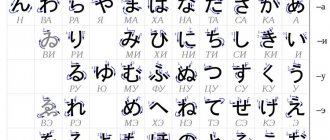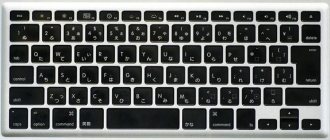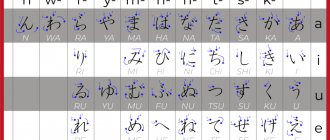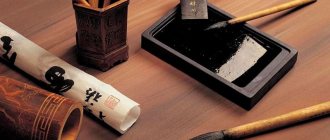Japanese keyboards for Android
Reading time: 4 min.
There are quite a few keyboards that support Japanese input, I tried to look at the three that, in my opinion, are the most convenient and modern.
GBoard
Google's Universal Keyboard, which you probably already have on your device, includes Japanese input. Supports both standard phonetic input via Romaji using QWERTY, and two unusual modes: using “daisies” from kana (12 Keys) and Romaji (Godan Keyboard). 12 Keys is very convenient, as it allows you to enter almost any syllable with one click and swipe in the desired direction. Godan Keyboard is designed for easy typing using romaji, with consonants grouped on the right and vowels on the left.
The Japanese keyboard can be installed separately from GBoard if that's all you need: Google Japanese Input
In addition, GBoard contains handwriting input, which can also be installed separately: Google Handwriting Input
SwiftKey
SwiftKey is another well-known keyboard that was recently acquired by Microsoft and made free for everyone. SwiftKey is billed as a keyboard with smart artificial intelligence that predicts what you want to type. It has the already familiar phonetic input modes using QWERTY and 12 Keys, which in the settings are called ローマ字 and ひらがな, respectively.
Simeji
Google Play, free (shows ads)
Simeji claims to be the most popular keyboard in Japan and claims a large selection of emojis and preset phrases for chats. 12 Keys here is called Flick and is highly customizable. In addition to Japanese, the keyboard allows you to enter only English, for which (like in GBoard) typing is available in the telephone keyboard layout.
Do you know any other good keyboards that support Japanese input? Leave a comment!
Source
How many characters are there in a Japanese keyboard?
As you know, in order to learn to properly understand and read works in the presented language, it is enough to know at least 2000 hieroglyphs. However, as for the number of all collected on equipment, this is a smaller number, namely about 50.
Accordingly, in Japan the design is almost similar to the domestic one. Of course, in addition to the basic Latin letters, it is equipped with hiragana. The typed text itself is printed in the same way as the words are spoken. This automatically converts hieroglyphs, which greatly simplifies the work.
If you don’t know how to choose another word, then you just need to click the right side of the mouse once and a window with suggested spelling options will be available to you.
ATTENTION! The keyboard of this option allows users to enter kanas at the same time. The writing method is similar to the previous one.
It is worth understanding that the structure is equipped with additional keys that allow you to switch different modes. As another difference, we can mention a different way of using the word program. There are certain parameters that are related to searching and moving text. Thus, the mentioned invention is no different from the one that is used in Russia every day.
Japanese language on Android
Reading time: 14 min.
Updated November 22, 2021
If you have an Android smartphone or tablet, you can easily turn it into a useful tool for learning anything, and, in our case, the Japanese language in particular. (On iOS the situation is definitely no worse, but more on that another time.)
I would like to warn you right away that, unfortunately, almost all applications in the review are in English. Only applications with Russian language would not be enough even for such a review.
One of the interesting things that I discovered is that ratings cannot be relied upon at all when choosing learning apps. The highest ratings are for applications that only create the appearance of learning due to simplicity - for example, hiragana and katakana trainers. Applications with serious content balance at level 4.0.
READ Games for windows live how to install without internet
LiveInternetLiveInternet
SneznyBars
all posts by the author
JAPANESE KEYBOARD.
The Japanese hieroglyph collection contains many thousands of characters. It is impossible to accurately determine its volume, since it is open, like the lexical fund of a language: some hieroglyphs fall out of use, new ones appear. It is believed that the minimum level of knowledge of the Japanese language includes about 2000 characters; this is usually enough to read Japanese newspapers and literature. But with such a huge number of characters used, what does a Japanese computer keyboard look like? It turns out that in addition to the main writing system - traditional hieroglyphs with which we are accustomed to associate Japanese texts, in modern Japanese there is also a syllabary alphabet. A hieroglyph is a pictogram that represents each whole word or concept. And each character in the Japanese syllabary means a syllable. This alphabet is called kana and it consists of two phonetic varieties - hiragana and katakana. The configuration of the signs of the syllabary alphabet was determined by the abbreviated spelling of one or another hieroglyph. In modern Japanese written text, kanji and kana alternate. As a rule, hieroglyphs are used to write the lexical part of the text (roots, stems), and hiragana is used to write its grammatical part (affixes, function words). Some words, primarily borrowed from other languages, are usually not written in hieroglyphs; katakana is used to write them. The syllabary alphabet has a small enough number of symbols to fit on a standard keyboard. Every Japanese word can be written in hiragana, according to rules similar to the rules of writing in European languages. So, the Japanese keyboard looks the same as the one we are used to. On its keys, in addition to Latin letters, there are symbols of the Japanese hiragana alphabet. The text is entered in Latin as it is pronounced. Conversion to hieroglyphs is done automatically. Consecutively typed Latin letters are converted into Japanese characters, and the text typed by them is converted into hieroglyphs. Just click on the right mouse button and a menu will appear above the word, at the top of which the system itself will offer different, most commonly used types of writing the word using hieroglyphs. The Japanese keyboard also allows you to enter kana characters directly. Printed in the same way as described above, with the difference that the intermediate translation from Latin to Hiragana is omitted. Japanese keyboards also have additional keys next to the space bar to switch between different input modes. Japanese Windows differs from ours only in that everything - inscriptions, messages, help, etc. translated into Japanese, the rest is completely similar. Except that in Word and some other programs there are several other parameters related to the peculiarities of search, hyphenation in Japanese text, and so on. Thus, the Japanese keyboard is practically no different in appearance from the one with which we are used to working every day!
example:
- we type, for example, in Latin letters ka , after which this syllable turns into か, written in hiragana. Following it we type, for example, the syllable sa :
- the syllable sa also turns into Japanese さ, after which we press the spacebar, and as a result, the hieroglyph kasa , and in translation - “umbrella”. Along with the “umbrella”, other options for kasa :
— by pressing the spacebar or using the arrows on the keyboard, select the desired option. If a hieroglyph is not needed, but a word written in katakana or hiragana is needed, we ignore the replacement and write further what is needed. This is how words, phrases, sentences, and so on are written.
Or, for example, like this - let's take a more familiar word :))) こ - type ko , ん - n , に - type ni , ち - chi , は - ha .
And we get “ konnichiwa ” - “hello!”:
:))) Moreover, you can turn your keyboard into Japanese. To do this, you need to select “Options...” in the lower right corner of the screen or where your language bar is displayed and, by clicking the “Add” button, check the box in the list that appears. opposite the Japanese language. After these procedures, the keyboard layout will change not only to Latin-Russian, but also to Japanese, and using the buttons on the language bar below, you can, for example, set the alphabet - katakana or hiragana. And so on.
Now you know what’s what, and if after this someone tries to assure you that Japanese keyboards have two-story keys and with foot pedals, feel free to tell such a person that he is wrong :))
CHINESE KEYBOARD.
The average Chinese uses 3000 hieroglyphs (I know from something from a geography teacher), it is known that the most complete Chinese dictionary “Qihai” (analogous to our Dahl dictionary) contains 57 thousand hieroglyphs. It is clear that the keyboard cannot contain even 1000 characters. Until recently, programs were used that adapted Latin words typed on the keyboard, transcription of Chinese hieroglyphs, the program offered a choice of several options for hieroglyphs, which one to use was decided by the user himself.
Now other keyboards are used, the operating principle of which is as follows: despite the fact that each hieroglyph is individual, conveys its own meaning, and also has a unique outline, you can repeat this outline using approximately 150 standard keys (the set of which most hieroglyphs consist), and by placing these keys on the keyboard, you can type the desired hieroglyph from different keys.
There are nine groups of dialects in China, and the national, state dialect is Putonghua (and what a variety of Chinese keyboards there are).
Well, actually the Chinese keyboard looks like this:
There are 16 million bloggers in China. They write everything. The Chinese language has several thousand characters and, of course, there is no standard keyboard layout. This means that no Chinese keyboard is similar to another. According to the type of layout, the keyboard is divided into five regions - left- and right-sided letters, vertical and horizontal additions and strikethroughs. In the picture, one of the possible layouts is “Woobie”. Professional bloggers achieve 160 characters per minute with this layout (an average of 500 keystrokes). There is a lot to learn from them.
https://www.youtube.com/v/HVZ2D721Rzo&color1=0x…ot;> name=”allowFullScreen” value=”true”> https://www.youtube.com/v/HVZ2D721Rzo&color1=0x…player_embedded&fs=1″ type=”application/x-shockwave-flash” allowfullscreen=”true” allowScriptAccess=”always” width=”425″ height=”344″> - here’s a video that clearly shows the first method of typing Chinese characters when the user types the English transliteration Chinese words and selects the desired one from the proposed option (in English).
Well, this is what a Chinese keyboard looks like for users who haven’t read this article
from the depths of the Internet.
Interface language
If you want all labels and buttons to be in Japanese, you can switch the interface language to Japanese if your device supports it. In this case, applications that support it will also switch to Japanese. If you are ready for such a test, select “Language & input” in the device settings; at the very top there will be a “Language” item. You will then be presented with a language selection list, where, if available, Japanese is displayed in Japanese (日本語) and is located towards the very end.
If you want to change the device language back from Japanese, then get into the list of languages: 設定 (Settings) - 言語と入力 (Language and input) - 言語 (Language).
If the Japanese language is not on the list, then - alas and ah - for the sake of the Japanese interface you will have to change the device (or firmware, if that’s your path). If you want to buy a device with support for the Japanese language, then one way is to first search for the device in Japanese online stores, for example, on the Japanese Amazon.
If your device supports the Japanese interface (see point above), then with almost 100% probability its standard keyboard will allow you to enter Japanese characters. But even if there is no Japanese keyboard included, there are many third-party ones that are in many ways even better than the standard ones.
How to type in Japanese
The article describes how to install the Japanese layout on your computer and how to print on it. Two input options (Romaji Input and Kana Input) are considered: features and difficulties of their use.
So you have mastered the Japanese alphabet, and the time has come to be able to not only write out signs by hand, but also type them on the keyboard.
In order to install the Japanese layout on your computer (Windows), click on the name of the language in the lower right corner and select “Language Settings”.
Then in the field that opens, select “Add a language” and find “Japanese”. Next, you can proceed in two ways: select the Romaji Input input method, so that when typing, syllables are formed when you press the corresponding letters of the Latin alphabet (for example, typing “sa” you will receive a さ sign), or the Kana Input input method: each button on your keyboard will be match one alphabet sign. Let's look at the features of printing in both cases.
Romaji input (input in Latin letters)
This choice is the most optimal because it does not require a long process of memorizing the location of the buttons. If you download the Japanese layout onto your phone, then you will most likely have to learn how to type in this particular way.
When printing, Hepburn transcription is used, that is, to obtain the following characters you need to press the following Latin letters: し = shi, ち = chi, つ = tsu, や = ya, ゆ = yu, よ = yo, わ = wa.
Signs with voiced or voiceless consonants are also formed using the corresponding Latin letters: が = ga, ぽ = po, etc. The voiced series SA is written through Z and J: za, ji, zu, ze, zo. Combinations with soft consonants are also written as they are heard, for example: じゃ = ja, ぎゅ = gyu, にょ = nyo. The small CU is obtained by entering the corresponding consonant twice: かっぱ = kappa, いっしょう = isshou, etc.
We will also consider more complex issues:
· To get the ん sign, press “n” twice.
· づ is printed as "du".
· を is printed as “wo” because it is part of the BA series, which once consisted of the characters wa, wi, we, wo.
· To print small alphabet signs that convey vowel sounds, you need to press “x” or “l” in front of it: ぁ = xa/la, ぃ = xi/li, ぅ = xu/lu, ぇ = xe/le, ぉ = xo /lo. The same principle is used to write open syllables, which can be small in Japanese: ヵ = xka/lka, ヶ = xke/lke, っ = xtsu/ltsu. However, it will not be possible to print the entire alphabet this way.
· To type ウェ or ウィ you need to press “w” and the corresponding vowel.
· Syllables with “f” will be written as they are heard: ファ = fa, フィ = fi, フェ = fe, フォ = fo.
· The combination ティ is printed as “thi” or “texi/teli”.
· The katakana vowel lengthening character (ー) is printed as a dash.
· Punctuation marks are typed by pressing the “b” (、), “yu” (。) and “.” buttons. (・).
· To type Japanese quotation marks, press the button where the Russian letter “x” is located for the opening bracket (「) and the “ъ” button for the closing bracket (」).
Kana Input
This method of typing in Japanese is simpler in terms of understanding how to write “complex” combinations of characters, but it requires a lot of time to develop typing speed. In addition, at the very beginning, you will have to be creative with this choice.
Dictionaries
All dictionaries below work without a network connection. A significant part of the dictionaries is based on one project - WWWJDIC (EDICT), so it makes no sense to analyze the completeness and accuracy of the definitions of each application - they are the same. Example sentences are most often taken from Tatoeba. But it makes sense to compare the interface, ease of search and various additional functions.
Akebi
Akebi is one of the best Japanese-English dictionaries for Android. Akebi has advanced search, for example, it allows you to search for entire words by radicals of individual kanji or using handwriting. Word cards have standard features like viewing example sentences, kanji stroke order, and radical parsing. Training in basic functions is built into the program.
Takoboto: Japanese Dictionary
Takoboto is another great dictionary. In addition to definitions in English, it contains about 7000 definitions in Russian (which is not that much), a convenient search for kanji by radicals, example phrases, and stroke order diagrams. For verbs, shows grammatical forms. If you wish, you can turn off the display of romaji.
Play Store, free (shows ads)
Another good Japanese-English dictionary. Includes convenient kanji search by radicals, stroke order diagrams, example sentences. Allows you to search for words by the position of a specific kanji in them. Shows advertisements, but only if there is a network.
READ How to programmatically install a picture 1c
YARKSI
Play Store, paid (trial period 30 days)
Version of the popular Japanese-Russian hieroglyph dictionary for Android. The main difference between Yarksi is its own database with the largest number of definitions in Russian. In addition, it allows you to search for kanji using the built-in handwriting input. In other respects, and primarily with its archaic interface, it lags noticeably behind other applications in this review. I couldn't get the pronunciation feature to work, but based on reviews, it reads words with a voice synthesizer.
Aoba Jisho
Aoba Jisho is the only dictionary I've come across that allows you to search for kanji by SKIP codes. Additionally, in the example sentences, different words are highlighted in different colors for simplicity, and there is an advanced word search. Otherwise, Aoba Jisho's features are pretty average.
Virtual Japanese Input System (IME)
Comments
sasha_rabu_rabu 12/20/2009 01:16 And how do you write subscripts i, yu, e??
Administrator 12/20/2009 01:51
When typing small characters are preceded by the letter x , for example: yu - ゆx yu - ゅ
Sevig 12/26/2009 08:08
Thanks for the program. Please tell me how to type the longitude sign in katakana ー and the duplicate consonant ツ?
Administrator 12/26/2009 13:10
The longitude sign is entered using the minus key on the keyboard, although you cannot enter it separately - it must be preceded by any katakana or hiragana sign. For example, you can press the combination mi- , which turns intoみー, and then delete the syllableみ. To enter a smallッ, it must be preceded by the letter x , as I wrote above. Those. press xtsu and then the conversion key to katakana F9 (and also back to hiragana).
udut 06/05/2010 10:54
How can I install this virtual system on my PC?
Administrator 06/06/2010 00:16
How can I install this virtual system on my PC?
Why install it when it just replaces the lack of Japanese language support on the computer? Install standard Japanese language support and that's it. Vladyushonag 06/21/2010 10:55
Administrator 06/21/2010 14:06
Happy soul mate! Write if you are interested. tolkach1939olegyandex.ru
Tiger 09/17/2010 22:36
I apologize for the stupid question, but how to write, for example, the letter o and have such a wavy line at the top?...
Administrator 09/17/2010 23:23
I apologize for the stupid question, but how to write, for example, the letter o and have such a wavy line at the top?...
o - お wo - を You can see the entire conversion table HERE Holo Wise 02/20/2011 15:43
My syllables are not converting!
Administrator 02/20/2011 19:24
To quote Holo the Wise:
My syllables are not converting!
What browser? It should work in Firefox, Opera, Internet Explorer (you must select the correct tab). Yuki 04/10/2011 20:09
How to install on Windows 7? T_T I've been suffering for a long time
Administrator 04/10/2011 20:14
How to install on Windows 7? T_T I've been suffering for a long time
Why did such a question arise here? As I understand, you are using a neutered, hacked version of Windows 7. I have not yet explored the possibility of returning language settings in this system, since I myself do not have a single device on the Seven. Yuki 04/10/2011 20:16
I quote Yuki: how to install Windows 7? T_T I've been suffering for a long time
Why did such a question arise here? As I understand, you are using a neutered, hacked version of Windows 7. I have not yet explored the possibility of returning language settings in this system, since I myself do not have a single device on the Seven. no, I’m sitting at the office, I tried to install the settings but it doesn’t work, sadly Administrator 04/10/2011 20:21
Well then, describe the symptoms of inoperability. Where you go, what you do and what you see. I just won’t have the system at hand, so I’m afraid that at the moment I’m unlikely to be able to provide meaningful assistance. But still.
Well then, describe the symptoms of inoperability. Where you go, what you do and what you see. I just won’t have the system at hand, so I’m afraid that at the moment I’m unlikely to be able to provide meaningful assistance. But still.
I go to the control panel, then change the keyboard layout, there I select Japanese, check the boxes everywhere, and it writes in English ( Administrator 04/10/2011 21:42
That is, the Japanese layout ( JP ) is present along with the Russian ( RU ) and English ( EN ) layout? If yes, then switch the keyboard using the combination Alt +
What doesn't work? Hiragana input method is also not selected in the Japanese keyboard? Have you already read the rest of the articles in this section?
That is, the Japanese layout ( JP ) is present along with the Russian ( RU ) and English ( EN )? If yes, then switch the keyboard using the combination Alt +
What doesn't work? Hiragana input method is also not selected in the Japanese keyboard? Have you already read the rest of the articles in this section?
they are selected and turned on, but simply do not function. I'll try to suffer some more, maybe it will work out Yuki 04/10/2011 21:56
Everything works, I'm just an idiot x))) thank you very much)
Oksana 06/20/2011 00:18
Administrator 06/20/2011 01:31
Hello.. some of my letters remain in the Latin alphabet.. maybe I missed something.. or that’s how it works, not everything can be translated into hieroglyphs?
Good afternoon, Oksana. Write in Latin what you are typing. If it leaves letters, then you are doing something wrong. Maria 09/12/2011 21:32
Directories
Tae Kim's Guide to Learning Japanese
Tae Kim's famous guide to Japanese grammar in English, in the form of an appendix. Works offline.
Educational apps
JA Sensei
Play Store, shareware (paid content available)
The Japanese language learning app provides comprehensive lessons on writing, grammar, and Japanese culture, with examples narrated by native speakers.
Obenkyo
A multifunctional learning application that includes hiragana, katakana, kanji, numbers and grammar particles trainers. I’m not a fan of exercise machines, from my point of view it’s more of a waste of time, but if you still include such an application in the review, then Obenkyo is probably the most versatile of them. The grammar section is the same as Tae Kim's grammar guide.
Gakusei
The application is a collection of questions in which you need to enter the answer yourself instead of choosing from ready-made options. Questions range from translating single words to entire sentences, both from Japanese to English and vice versa. It is the Android version of the open source web application learn.fragments.me, where you can try the method without installing the application.
The application is interesting, but there are some doubts about the quality of the base.
Entering characters
The services we mentioned above allow you to type only syllabary characters. But what if you need kanji? Here you already need a site with online input of Japanese characters . Let's look at a couple.
The first service, no matter how trivial it may sound, is Google Translator. Yes, first of all, it is still a translator, but it has one big advantage: it has a built-in function for handwriting Japanese characters online . It’s simple: in the left window, select the Japanese language, and then in the lower right corner, click on the arrow, then on “handwriting input” - this function is indicated by a pencil icon. Google perfectly recognizes handwritten characters - it not only processes even the crooked hieroglyphs, but also offers several similar options. There you can enter kanji from your keyboard. You simply type a Japanese word in Latin letters, which is automatically converted into alphabet characters, press space, and the alphabet changes to a hieroglyph. Press the spacebar several times and you will see possible options for a given reading.
If for some reason Google Translator is not suitable for you, then pay attention to the site https://www.bolden.ru/japanese/tech/setup/virtual-ime.html. There is no handwriting input, but this is another good option for a Japanese online keyboard with hieroglyphs . The usage pattern is similar to Google.
Our short article has come to an end, thanks for reading! We hope you found it useful. What websites do you use to learn how to use the Japanese keyboard? Share in the comments. We wish you success in learning Japanese and see you again!
Japanese keyboard online - we tell you where to find it and how to type. Let's use handwriting of Japanese characters online together!
Source
Dive
Radio Japan
Play Store, free (shows ads)
An application for listening to Japanese online radio stations, music and more.
Moe Moe Japanese
Play Store, free (shows ads)
A set of professionally voiced spoken phrases in a cute girl's voice with translation into English. If you decide to use these phrases as they are in real life, then unless you are the girl in the picture below, you will look very stupid.
Shizuku Talk
Play Store, shareware (paid content available)
Shizuku is a cute animated girl created to demonstrate Live 2D technology. Shizuku has an impressive set of voiced phrases in Japanese, although they are presented without any subtitles, and the sound quality in some places leaves much to be desired. Some phrases are paid and are sold individually for some strangely large amounts of money, in my opinion (about $1 per piece).
Source









